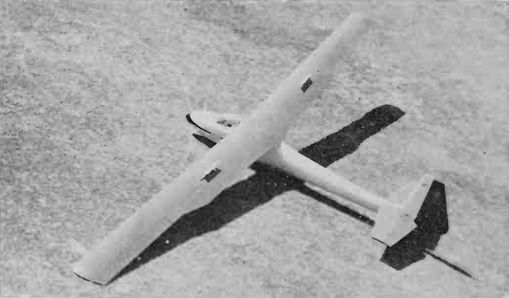
M.Hardy. Gliders & Sailplanes of the world
KS-II Kartik
One of the indigenous types designed and produced at the Technical Centre of India's Civil Aviation Department, the Kartik high performance single-seater was designed by S. Ramamritham, who later became Director-General of the Centre, and first flew in prototype form, designated KS-I, on 18 March 1963. It performed successful stalling and spinning trials that same day and was followed by a second prototype. An unusual feature of the KS-1 was its 'double rectangular' wing planform in which the constant chord outer panels were joined to the larger, constant chord centre section with just a large fillet where the change of chord took place; this absence of taper minimised the number of different ribs required for a tapered wing, easing production and ensuring close control of the accuracy of the aerofoil section. A third prototype, designated KS-II, first flew on 4 May 1965 and this had a conventional tapered wing to allow flight evaluation of the relative performances of the two wings; fabric-covered slotted wooden ailerons replaced the KS-I's plywood-covered wooden ones. Other changes in the KS-II included a slight increase in fuselage length and a reduction in cockpit height, and second, third, fourth and fifth prototypes of the KS-II were test flown during February 1967, March and May 1968 and May 1969, plus a sixth prototype in 1970. The third and subsequent aircraft incorporated several improvements, including a reduction in fuselage height improved forward vision and seating, and larger air brakes, while the ninth KS-II Kartik, flown in 1976, has the air brakes replaced by trailing edge slotted flaps. The KS-II was type certificated in 1965 and during the first Indian National Gliding Rally, held in 1967, the Kartik scored many successes, including setting a national speed record over a 200km triangular course.
The Kartik is of conventional wooden construction, the high cantilever wings having one main spar, one rear spar and a diagonal spar at the root; the torsion box back to the rear spar is plywood-covered and the trailing edge fabric-covered. There are retractable wooden air brakes above and below the wing. The semi-monocoque fuselage is plywood-covered and has a glassfibre nose cap, while the wooden tail unit has a plywood-covered fin and the other tail surfaces are fabric-covered with ply covering on the leading edges; there is a trim tab in the starboard elevator. Landing gear consists of a non-retractable Palmer/Dunlop unsprung monowheel, with a drum brake, and a rubber-sprung nose skid with a replacement steel-shoe; there is also a tail skid which is sprung by ordinary tennis balls. The pilot sits under a rearward-opening hinged Perspex canopy, and oxygen equipment is optional.
Data: KS-II
Span: 49 ft 2 1/2 in
Length: 24 ft 2 in
Height: 7 ft 5 in
Wing area: 145.7 sq ft
Aspect ratio: 16.6
Empty weight: 463 lb
Max weight: 705 lb
Max speed: 124 mph
Max aero-tow speed: 71 mph
Min sinking speed: 1.97 ft/sec at 40 mph
Best glide ratio: 31:1 at 47 mph
- M.Hardy. Gliders & Sailplanes of the world
Фотографии
-
Jane's All the World Aircraft 1964 / 03 - Sailplanes
KS-I Kartik single-seat high-performance sailplane
-
GL 1982- / M.Hardy - Gliders and Sailplanes /Gliders & Sailplanes of the world/ (1)
Регистрационный номер: VT-GEP KS-II Kartik.
-
Jane's All the World Aircraft 1966 / 05 - Sailplanes
KS-II Kartik single-seat high-performance sailplane
-
Jane's All the World Aircraft 1976 / 03 - Sailplanes
Регистрационный номер: VT-GEB KS-II Kartik single-seat high-performance sailplane in its current form
-
Jane's All the World Aircraft 1972 / 03 - Sailplanes
Регистрационный номер: VT-GDP KS-II Kartik single-seat high-performance sailplane in its latest form
- Фотографии




